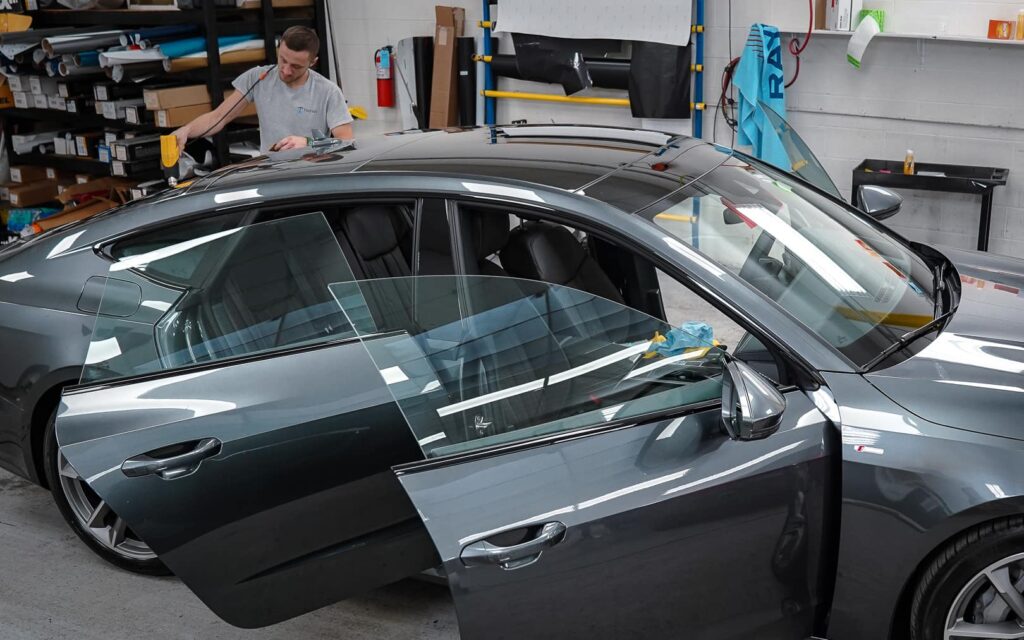A Comprehensive Overview to Solutions Provided With Home Window Tint Solutions
Home window tinting has actually ended up being an essential service for both commercial and household setups. It uses numerous movies designed to satisfy particular needs, such as warmth reduction and personal privacy improvement. Understanding the series of alternatives offered is essential for making notified choices. This guide will discover the different sorts of home window tinting films, their benefits, and the installment procedure. It will also address lawful considerations that might influence your choices. What variables should one consider prior to proceeding?
Kinds Of Home Window Tinting Movies
Window tinting movies can be found in various types, each designed to fulfill details requirements and choices. The most usual types include colored, metalized, ceramic, and crossbreed movies. Dyed films provide a fundamental degree of privacy and warm reduction, using a dye layer to absorb warm. Metalized films integrate tiny metal particles, using enhanced warm rejection and glow reduction while likewise adding toughness. Ceramic films attract attention for their superior performance, as they block warmth without hindering signal transmission, making them perfect for electronic devices. Hybrid movies combine elements of both colored and metalized movies, offering an equilibrium between visual charm and functional benefits. Each film kind differs regarding light transmission, UV protection, and warranty choices, enabling consumers to select a solution that straightens with their specific needs and design choices. Understanding these options is essential for making a notified choice when taking into consideration window tinting remedies.
Advantages of Residential Home Window Tinting
Residential window tinting offers a variety of advantages that improve both convenience and energy effectiveness in homes. One of the key benefits is the decrease of warm gain, which leads to reduce energy expenses by reducing the reliance on air conditioning systems. In addition, window tinting assists to obstruct hazardous UV rays, safeguarding both occupants and furnishings from sunlight damages and fading.Moreover, it improves privacy without jeopardizing all-natural light, enabling property owners to enjoy their views while maintaining prying eyes at bay. The application of window movie additionally improves safety by holding destroyed glass in place throughout storms or mishaps, thereby decreasing injury risks.Furthermore, household home window tinting can add to an extra aesthetically pleasing exterior, as numerous film choices are available to match different architectural designs. On the whole, these benefits make window tinting a practical and beneficial investment for homeowners looking for improved livability and power performance.
Benefits of Industrial Window Tinting
While numerous businesses look for methods to improve their job environment, business home window tinting offers a multitude of benefits that can considerably enhance both worker convenience and functional performance. One primary advantage is the reduction of glow, which can considerably boost performance by allowing staff members to work without distractions from severe sunlight. In addition, home window tinting can help manage indoor temperature levels, resulting in reduced dependence on air conditioning and lower power costs.Furthermore, tinted home windows provide UV defense, protecting workers and furnishings from hazardous rays that can cause skin damage and fade products. This protection not only adds to a much healthier workplace but likewise extends the life of workplace insides. Ultimately, industrial home window tinting can enhance privacy, allowing services to maintain a specialist appearance while minimizing outside interruptions. Overall, these advantages make industrial window tinting a useful financial investment for companies intending to enhance their work area.
The Window Color Installation Refine
A successful home window color setup process entails a number of key actions to guarantee ideal results. The area and windows should be thoroughly cleansed to remove dirt, oil, and any kind of other impurities that could affect adhesion. Next, the color movie is very carefully determined and reduced to fit the details dimensions of each window.Following this, the installer uses a solution to the glass surface area to permit repositioning of the movie before it adheres. The movie is then put onto the window, ensuring it is devoid of bubbles and creases. When located properly, a squeegee is utilized to get rid of excess water and air.Finally, the edges of the film are cut for a neat finish, and the installation is checked for high quality. Proper attention to these actions assures the durability and performance of the window color, improving both aesthetic appeals and functionality.
Upkeep and Look After Your Window Color
Just how can one ensure the durability and look of window color? Appropriate upkeep and care are necessary. It is recommended to wait at the very least 30 days after installation prior to cleaning the tint to permit for appropriate bond. Once this period is over, utilizing a soft towel or microfiber towel can protect against scratches while cleaning. Gentle, ammonia-free cleansers must be used to prevent harming the film.Regular assessments of the sides and surface can assist determine any bubbling or peeling off early, enabling prompt repairs. Prevent utilizing unpleasant products or rough chemicals that could break down the color. Additionally, auto parking in shaded locations or using sunshades can reduce UV exposure, further securing the color's honesty.
Lawful Considerations for Window Tinting
Lawful considerations for home window tinting differ considerably throughout various states. Each state has details laws relating to noticeable light transmission limits, which dictate just how much light can travel through tinted home windows. Furthermore, some states provide clinical exemptions, allowing people with specific problems to use darker colors than normally permitted.
Tinting Regulations by State
While home window tinting can enhance a vehicle's appearances and supply added personal privacy, it is crucial for lorry owners to understand the differing regulations that control tinting throughout various states. Each state has its own particular laws concerning the acceptable levels of color darkness, reflection, and the sorts of home windows that can be tinted. Some states allow darker colors on back home windows but enforce stricter limitations on front side home windows. In addition, particular states may require details tags or certifications to verify compliance. Falling short to follow these regulations can cause fines or the need to get rid of the color (Davinci of Michigan Window Tinting). Subsequently, automobile owners need to research their state's legislations before investing in window tinting services
Noticeable Light Transmission Boundaries
Understanding the visible light transmission (VLT) restrictions is vital for any person taking into consideration window tinting. VLT refers to the portion of visible light that can travel through the tinted glass. Different states have differing regulations relating to acceptable VLT degrees, particularly for various windows in vehicles. As an example, front windscreens typically have more stringent restrictions compared to side and back windows. Violating these regulations can cause penalties and the need to remove non-compliant tinting. Therefore, it is crucial for people to investigate their state's details VLT regulations prior to proceeding with window color setup. Conformity guarantees not only lawful adherence however additionally security and exposure while driving, anonymous advertising a safer setting for all roadway users.
Medical Exceptions for Tinting

Choosing the Right Home Window Tinting Service
Choosing the right home window tinting solution involves a mindful assessment of private tinting needs. It is necessary to evaluate different service choices, guaranteeing they line up with the preferred results. Additionally, understanding the lawful look at this site laws regulating window tinting can aid prevent possible problems down the line.
Assessing Tinting Requirements

Assessing Solution Options

Recognizing Lawful Laws
Before picking a home window tinting service, people have to comprehend the lawful regulations regulating tinting in their location, as these regulations can differ considerably between states and municipalities. Each territory may enforce certain limitations on the allowable color darkness, reflective homes, and which home windows can be tinted. Some states might permit darker colors on rear home windows while prohibiting them on front home windows. Furthermore, regulations typically detail the sorts of products that can be used and may need specific labeling or certification. Failing to adhere to these regulations can result in penalties or the need to get rid of the color. Subsequently, possible clients need to verify the legality of their preferred color and get in touch with experts knowledgeable about local regulations to ensure conformity.
Frequently Asked Questions
The Length Of Time Does Window Tinting Commonly Last?
The durability of window tinting normally varies from five to 10 years, depending on variables such as the quality of the film, installation process, and ecological conditions. Routine upkeep can likewise influence its life-span considerably.
Can Window Tinting Be Gotten Rid Of Conveniently?
The ease of home window tint elimination depends upon the installment approach and glue made use of. Typically, expert services assure more secure, cleaner elimination, while DIY attempts might result in damages to the glass or glue deposit.
Will Window Tinting Affect My Home's Resale Value?
Window tinting can affect a home's resale value favorably or adversely. Possible purchasers may value energy cost savings and privacy, while others might watch it as a personal choice, influencing total charm and desirability of the home.
Exist Eco-Friendly Window Tinting Options Available?
The questions about environmentally friendly window tinting choices reveals that a number of producers now supply products making use of sustainable materials. These alternatives can lower energy usage and improve comfort while straightening with eco aware techniques in home improvement.
Can Window Tinting Assist With Energy Performance?
Home window tinting can considerably improve power performance by view website minimizing warmth gain and loss. This helps maintain comfortable interior temperatures, possibly reducing heating & cooling costs, while likewise adding to a more sustainable atmosphere with minimized power consumption. The application of home window film also enhances safety and security by holding shattered glass in location during crashes or storms, thereby minimizing injury risks.Furthermore, residential home window tinting can add to a much more aesthetically pleasing exterior, as different movie options are available to match different building styles. In addition, home window tinting can help manage indoor temperature levels, leading to decreased dependence on air conditioning and reduced energy costs.Furthermore, tinted home windows provide UV protection, protecting staff members and home furnishings from dangerous rays that can trigger skin damage and fade products. Some states enable darker tints on back windows yet enforce stricter limits on front side windows. Prior to selecting a window tinting solution, individuals should understand the lawful laws controling tinting in their area, as these regulations can vary significantly in between communities and states. Some states might allow darker colors on rear home windows while banning them on front home windows.